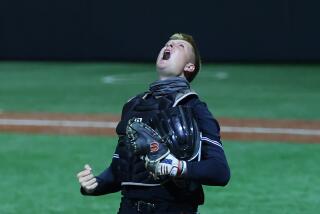Story of Baseball These Days Is a Tall Tale
- Share via
Pedro Martinez is talking about the giants in baseball. Barry Bonds? Hardly. The New York Met ace means today’s trend of scouting, signing and promoting really tall players.
All over, Martinez sees the difference. Fields full of guys who seem to have stepped from another sport.
“I think there are people who don’t do so well at basketball and they think, ‘Let me try pitching,’ ” Martinez said. “There are a lot of them.”
In a corner of New York’s spring-training clubhouse, Martinez caught the eye of reliever Billy Wagner. Martinez winked.
“The only one it didn’t work for was me -- me and Billy the Kid,” he said.
Both on the smallish side, they throw plenty hard. But nowadays, it sure helps to bring the height, as well as the heat.
“I think we’re all looking for the stud guy, the big specimen,” St. Louis General Manager Walt Jocketty said.
Sizing up the majors, it’s true: The big leagues are getting bigger and bigger, and not only in a juiced-up sort of way.
For every mighty mite such as David Eckstein and Jimmy Rollins -- All-Stars at shortstop, naturally -- there’s a Loek Van Mil. Haven’t heard of him? He’s the 7-foot-1 minor league pitcher trying to make it with the Minnesota Twins.
In the 1960s, Boog Powell and Willie McCovey were big boppers. At 6 feet 4, they’d barely get noticed now. Then there was home-run champion Frank Howard, a former Ohio State hoops star who stood out at 6-7.
A triple-A coach for the Yankees, the man called “Hondo” has found himself eye to eye with current players.
“You’re getting bigger, faster, stronger athletes,” Howard said. “You’re looking at middle infielders that are 6-foot-3, 6-foot-4, 215-220 pounds. Very gifted individuals.”
Check out how things have changed for the Milwaukee Brewers in the last decade.
This year, all 40 players on their roster at the start of camp were listed at 6 feet or taller. In 1996, the Brewers used 11 players who were 5 feet 11 or under.
“We’ve got a lot of kids who are still growing,” Brewer Manager Ned Yost said. “They’re going to get even bigger. We’ve got babies out there.”
No one named Big Baby, though. No one anywhere in the bigs called Pee Wee, the Toy Cannon or the Baby Bull, either.
“Not too many guys around like me,” said Eckstein, the Cardinals’ 5-foot-7 whirlybird.
Of course, heights can be subjective. At least the ones printed in media guides, that is. Adding a couple of inches here and there, it’s been done.
Yet in the search for more power at the plate and on the mound, the numbers that show up are daunting.
As in: Only 17% of the players on spring rosters checked in at under 6 feet. Eight teams -- yes, including the Giants -- listed every pitcher at 6 feet or more. And half of Tampa Bay’s players were 6-3 and up.
At the top in stature is Randy Johnson. Despite his awards, strikeouts and World Series rings, his height often stands out most.
“I’m still Randy Johnson, 6-foot-10 guy,” the New York Yankee star said. “I was somewhat of a successful pitcher and showed promise in high school, and that’s why I got drafted and had a scholarship offer. If you’re a young kid like that that’s 7-foot tall, I know what he’s going through.”
It helped San Diego pitcher Chris Young, a 6-10 basketball standout at Princeton. Same for Washington pitcher Jon Rauch, at 6-11 the tallest player in baseball history.
Marcus Giles, Atlanta’s All-Star second baseman, didn’t attract such attention as a youngster. Being 5-8 had a lot to do with it.
“I got drafted in the 53rd round, and I didn’t even know there was a 53rd round,” he said. “The day that happened, I told my dad I wanted to quit baseball. I told him that if that’s how the scouts and teams were going to look at me, I was done. I told him I would go become a fireman or policeman.”
Where he might not have reached the height requirement, in fact.
Met scout Howie Freiling sympathizes with a smaller player’s fate.
“They’re behind the eight ball,” he said. “There are places for them in the majors. But all things being equal, it’s the big kids who are going to get a look.”
While the Mets’ Martinez and Wagner are listed at 5-11, they’re the exceptions. It’s no secret that, throughout the majors, there’s an unwritten rule that right-handed pitching prospects need to be at least 6 feet to get a serious look. Since lefties are tougher to find, scouts can’t be as picky with them.
As a boy, Eckstein heard his dad tell him what fathers always tell their Little Leaguers: That unlike football and basketball, baseball was a sport anyone of any size could play. As a teen, he was determined to prove he belonged with the big boys.
More to Read
Go beyond the scoreboard
Get the latest on L.A.'s teams in the daily Sports Report newsletter.
You may occasionally receive promotional content from the Los Angeles Times.










